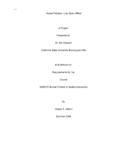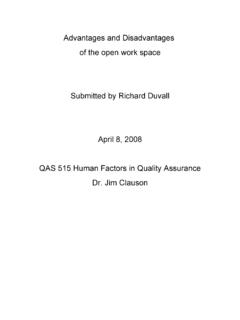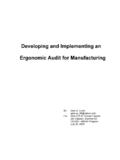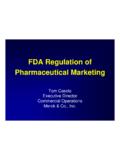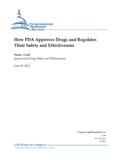Transcription of THE APPLICATION OF LEAN THINKING TO …
1 THE APPLICATION OF LEAN THINKING TO pharmaceutical QUALITY. SYSTEMS, DEFINING THE FDA AS THE CUSTOMER. _____. A Thesis Presented to the Faculty of California State University Dominguez Hills _____. In Partial Fulfillment of the Requirements for the Degree Master of Science in Quality Assurance _____. by Scott Douglas Stratton Fall 2004. Copyright by SCOTT DOUGLAS STRATTON. 2004. All Rights Reserved THESIS: THE APPLICATION OF LEAN THINKING TO pharmaceutical . QUALITY SYSTEMS, DEFINING THE FDA AS THE CUSTOMER. AUTHOR: SCOTT DOUGLAS STRATTON.
2 APPROVED: William Trappen PE, MSQA. Thesis Committee Chair Gerald VerDuft, MSQA. Committee Member Nannette Monreal, MSQA. Committee Member TABLE OF CONTENTS. PAGE. TITLE PAGE .. i COPYRIGHT ii APPROVAL iii TABLE OF iv ABSTRACT .. vi CHAPTER. 1. 1. 1. Statement of the Problem .. 6. Purpose of the Study .. 8. Theoretical Bases and Organization .. 10. Limitations of the 11. Definition of Terms .. 12. 2. REVIEW OF THE LITERATURE .. 20. 3. 28. Design of the 28. 30. Value Stream .. 36. Flow .. 55. 61. 66. Additional Lean THINKING 68.
3 Iv CHAPTER PAGE. 4. RESULTS AND DISCUSSIONS .. 72. 5. SUMMARY, CONCLUSIONS AND RECOMMENDATIONS .. 80. REFERENCES .. 89. v ABSTRACT. This thesis presents the theory of Lean THINKING and applies the processes and techniques identified for manufacturing operations to pharmaceutical quality systems under the Food and Drug Administration (FDA). regulation. The FDA is defined as the customer. The product is defined as the deliverables required by the FDA of the quality systems to ensure compliance with the applicable laws, regulations, and guidance documents.
4 The evolution of the FDA is examined to understand its intent in protecting the drug consumer, increasing authority, increasing enforcement capabilities, current expectations of pharmaceutical manufacturers, and the cost of non- compliance. The evolution of Lean THINKING is also examined. The five key principles of Lean THINKING : value definition, value stream identification, flow, pull, and perfection are extrapolated to pharmaceutical quality systems. This extrapolation results in a detailed identification of the quality systems components, their associated responsibilities, and the value streams necessary to ensure compliance.
5 1. CHAPTER 1. INTRODUCTION. Background The background includes the evolution of the United States Food and Drug Administration (FDA) from its inception to its current, and increasing, level of regulation, enforcement authority, and quality requirements. This includes key laws and acts passed to provide protection to consumers of pharmaceutical products. A review of consumer injuries and deaths resulting from consumption of adulterated, unregulated, untested, and unapproved products that provide the driving force behind the regulations and acts follow.
6 Enforcement activities by the FDA resulting from noncompliance are also reviewed. Finally, the evolution of lean THINKING and the key benefits are reviewed. From the beginning of civilization people have been concerned with the quality and safety of foods and medicines. The American colonies had federal inspection control over imported drugs starting in 1848. The FDA began in 1862. with a single chemist in the Department of Agriculture. In 1906, the Food and Drug Act came into effect, which began the modern era of the FDA by adding regulatory functions to the scientific mission.
7 This act prohibits interstate commerce of misbranded and adulterated foods, drinks and drugs. Drug safety and labeling was not addressed in the act. After multiple name changes, in July 1930, the FDA, as it is still known today, came into existence. Although 2. significant, the Food and Drug Act had gaps. Some products legal under this act resulted in serious consumer harm, as well as sales of ineffective drugs, such as Banbar - a worthless cure for diabetes or Lash-Lure - an eyelash dye that blinded many women.
8 Many foods were deceptively packaged or labeled: Radithor - a radium containing tonic that caused a slow and painful death, Wilhide Exhler a falsely promised cure for tuberculosis and other pulmonary diseases, and finally, in 1937, Elixir Sulfanilamide - a new wonder sulfa drug containing a toxic chemical analogue of antifreeze which resulted in over 100 deaths, many of whom were children. These and many other similar instances resulted in the1938 passage of the Federal Food, Drug and Cosmetic Act (FD&C). The FD&C required new drugs to be tested for safety and efficacy, to receive approval before marketing, and to have adequate labeling for safe use.
9 Medical devices and cosmetics were also included in the act. Equally important, the FD&C. provided the FDA with enforcement tools, such as the authority to perform factory inspections and issue injunctions. Within two months of the passage of the act, the FDA identified many drugs that could not be labeled for safe use directed by the patient. These drugs would require a prescription from a physician. This began the major debate between the FDA, drug industry, and health practitioners over what required a prescription.
10 In 1941, Sulfathiazole tablets killed and injured hundreds of people due to contamination, resulting in a drastic revision of the manufacturing and quality requirements leading to what would later be know as Good Manufacturing Practices (GMP). In 1962, the Kefauver-Harris Drug 3. Amendment passed. This amendment required the drug manufacturers to prove to the FDA the effectiveness of their products before marketing them. The amendment also required the FDA to assess the efficacy of all drugs introduced since 1938, transferred the regulation of prescription drug advertising, and established GMP for the drug industry.
